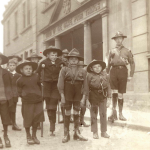On a freezing cold March morning, I walked up the drive of Chiswick House and Gardens to meet up with volunteer archivist, Kathryn Elliott, who shared some research with me. This research, by Pam Bater, the former archivist at Chiswick, shows the gap between the rich and the poor when it came to the treatment of the mentally ill. Between 1892 and 1928, Chiswick was a private asylum, run by the Tuke family, who rented the house from the Duke of Devonshire. At this time, the house retained two wings, constructed in 1788. This arrangement gave ample space for a surgery, consulting room, nurses’ mess and accommodation for staff and patients. There was also an ‘Acute Wing’. The Tukes also used the main house for family as well as for funding raising events.
Treatment was centred more around therapeutic methods than medication or restraint.
In an 1896 report by the Commissioners in Lunacy and the Board of Control, it was stated that ‘the rooms are warm and comfortable’. Other reports noted the extensive use of the grounds by patients. In the 1901 census, there were 34 patients and 48 staff plus the Tuke family and their household staff. Treatment was centred more around therapeutic methods than medication or restraint.
When the Charles Molesworth Tuke died, in 1925, his obituary read ‘The phrase “Tuke of Chiswick” is known and respected far beyond the bounds of psychological and general medicine. He made for himself a name that will be lasting and that stands for all that is best and most human in the treatment of insanity.’ It would appear that the house, once a trailblazer for Palladian architecture in England, was now the home of a trailblazer for medicine.
With thanks to Pamela Bater for permission to quote from her research, published in Brentford & Chiswick Local History Journal No. 14 2005.









